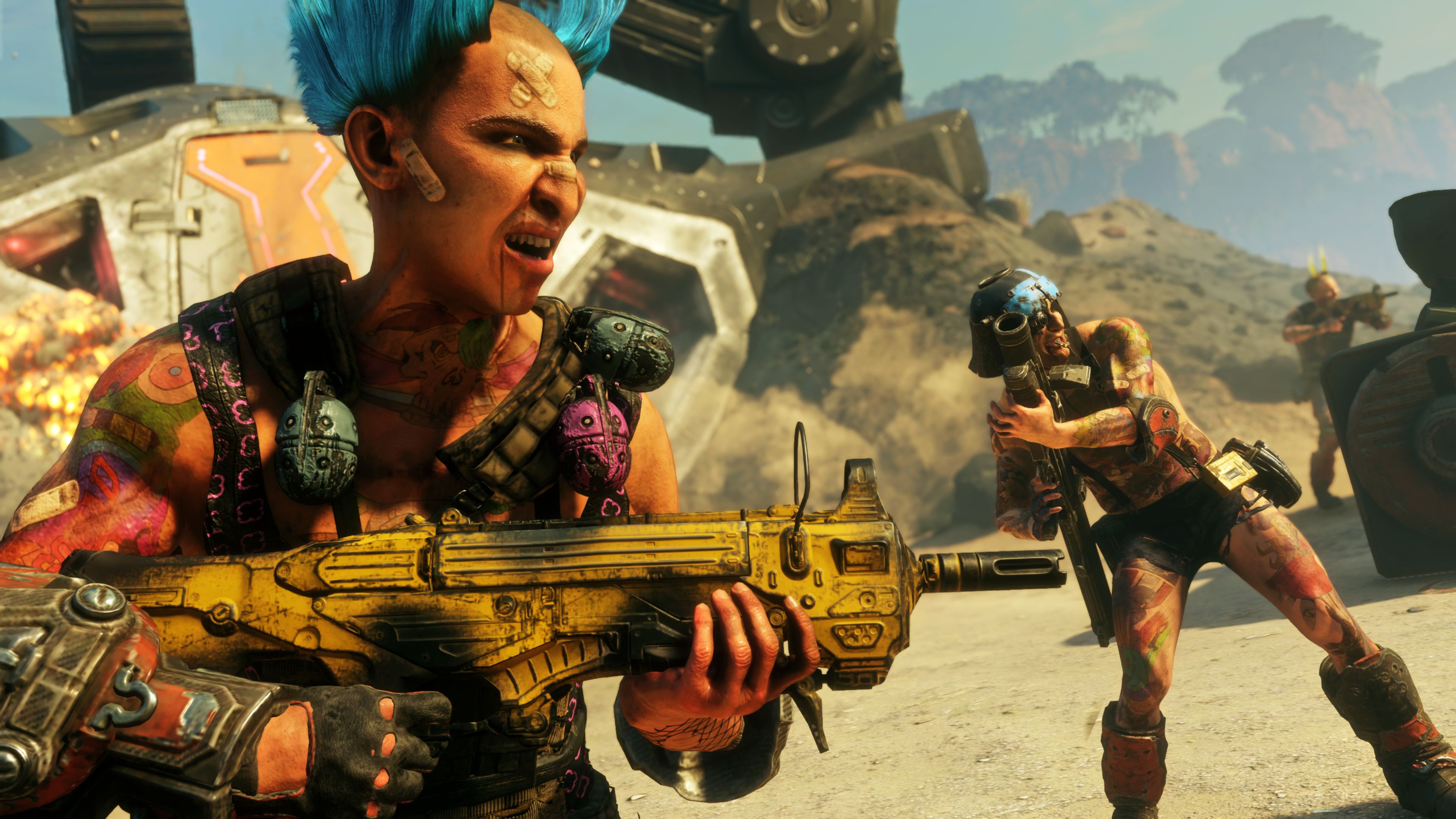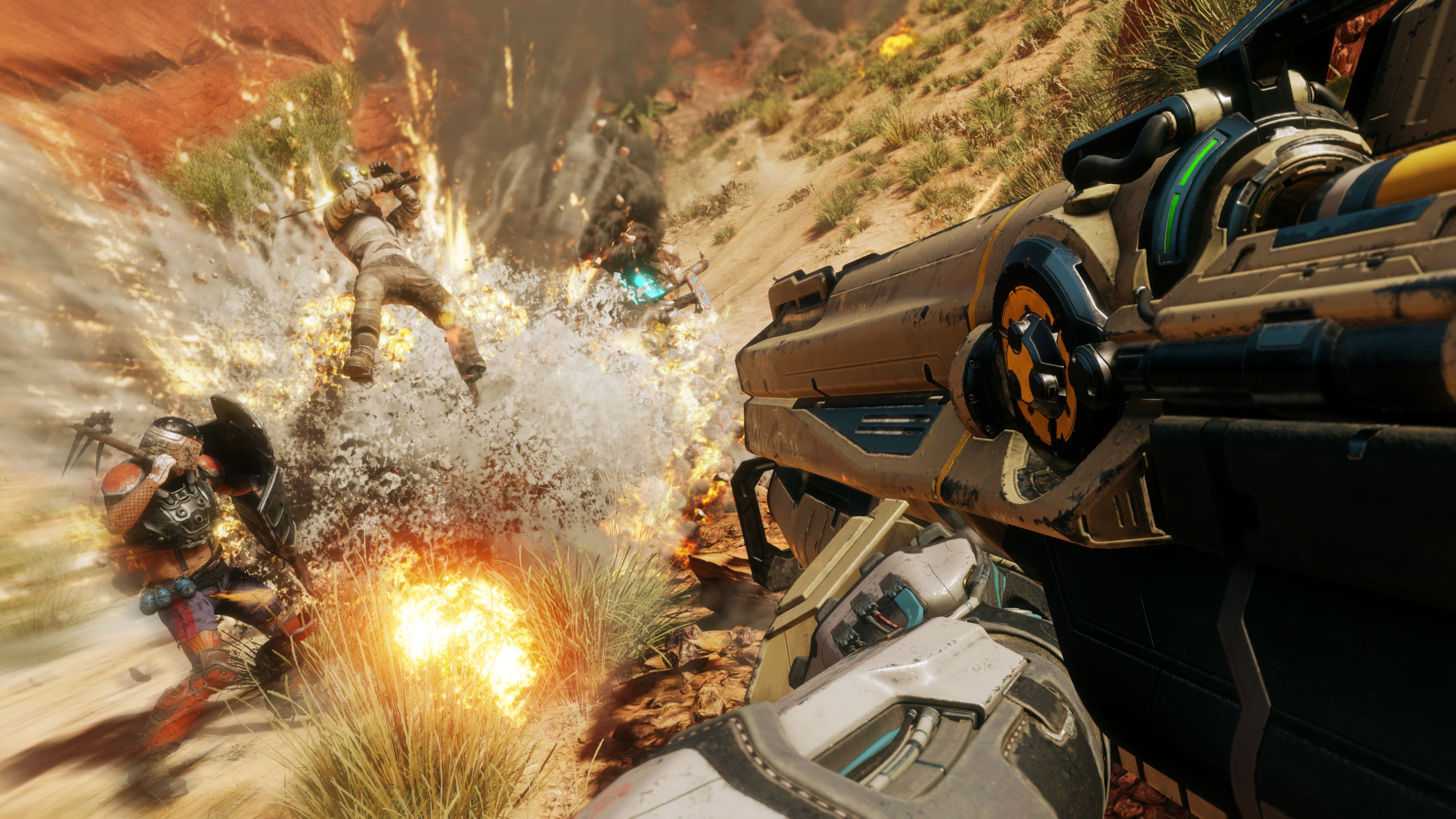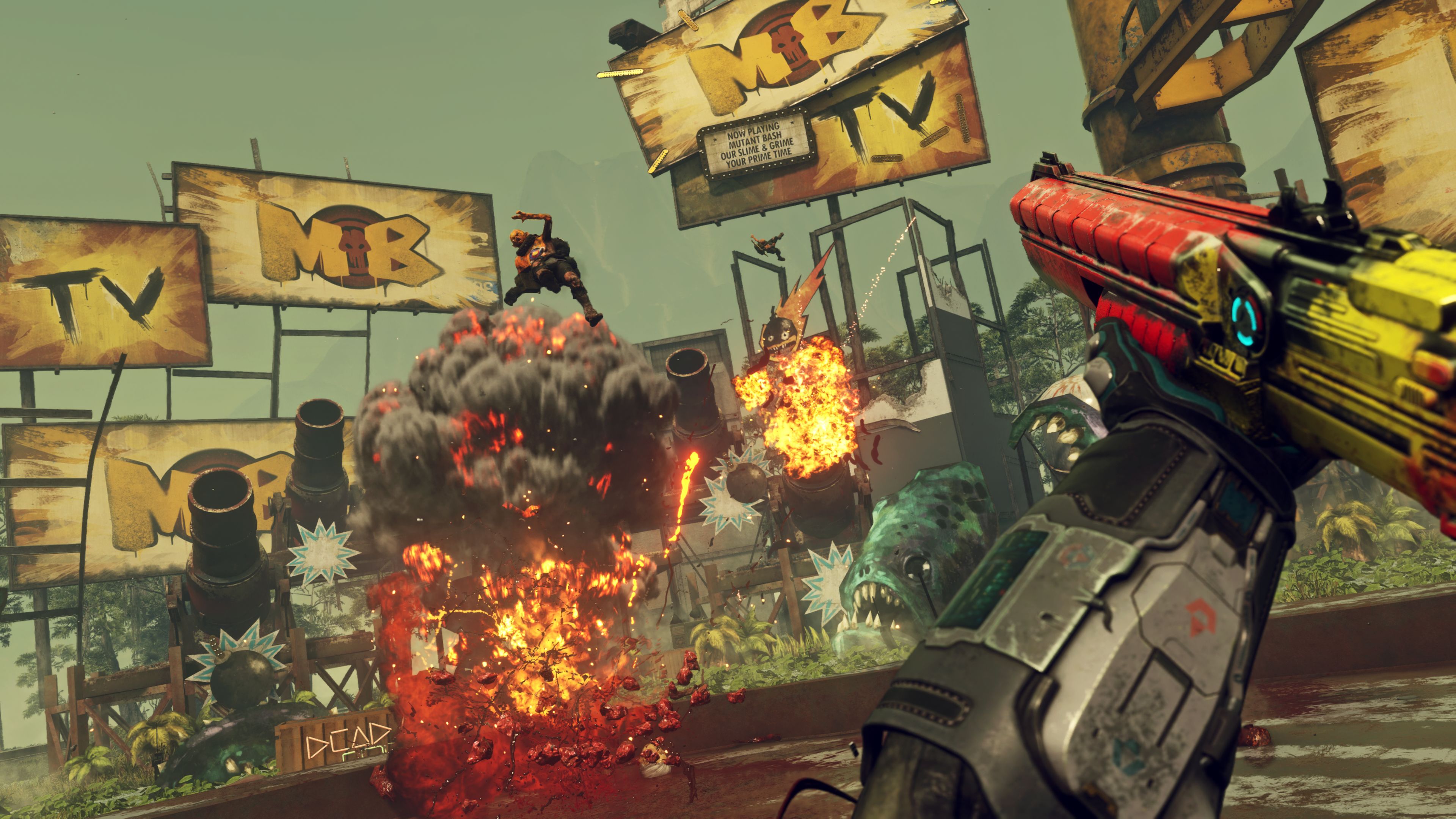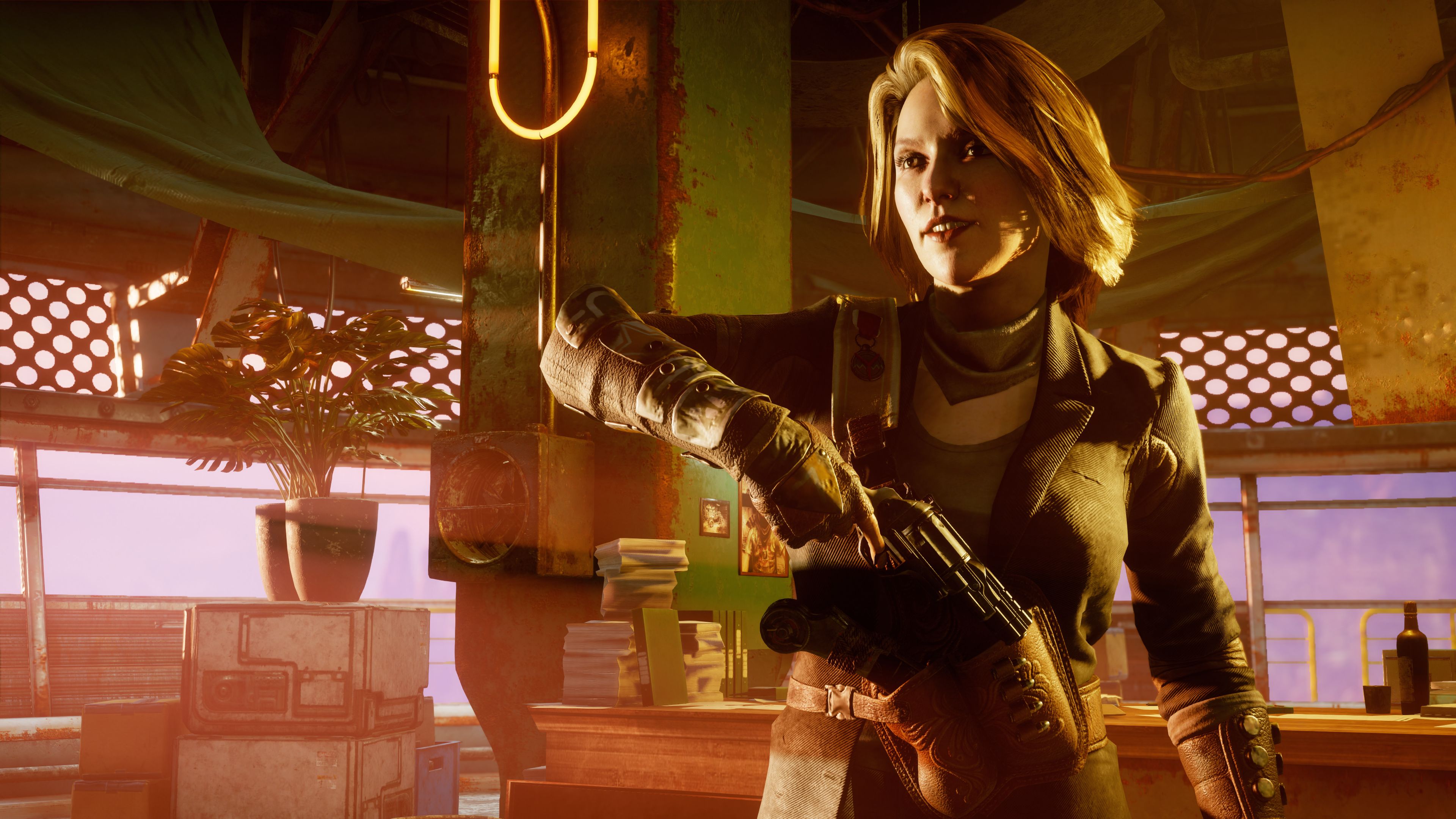Rage 2 has id-quality shooting, but I wish the world had more personality
It's more ridiculous than Rage, but does it go far enough?

Despite the number at the end of its name, you'd be forgiven for assuming Rage 2 has little to do with its predecessor. The original Rage was dry, mostly linear, and frequently described as 'solid'—a sort of critical shorthand for 'yeah, this is good, but…' The sequel feels more brash and vibrant. In short, Rage 2 is the sort of game that has Andrew W.K. playing over its trailer.
"The first thing I wrote on the whiteboard when I met with the team was 'more crazy than Rage'," says Tim Willits, id Software's studio director. "Time and time again we told those guys, 'Everything is on the table. Everything is possible.' If they'd wanted to make 12-foot cockroaches that you ride, we would have done it. We don't have them, but we could. One of the great things about the Rage universe is there's nothing that is too over the top. That's what people like, so we've tried to steer into it."
Having played a chunk of Rage 2, I can confirm the lack of giant roaches, which is almost a shame. It is more over the top, but not as much as I was expecting or hoping. Nevertheless, an hour into my session that I find myself competing in Mutant Dash, a sort of wave-based arena combat challenge that takes the form of a TV show set in a rundown warehouse unconvincingly decorated with gaudy cardboard cutouts. So that's something.
The team responsible for Rage 2's more exaggerated style isn't id, but Avalanche, creators of the Just Cause series. "It's a more holistic collaboration," explains Willits. "Avalanche is the developer, but we have people at id that have helped when they can. We have everyone from the controller guys, to the animation team, the art team, some of the designers. We work with those guys everyday."
"'Everything is on the table. Everything is possible.' If they'd wanted to make 12-foot cockroaches that you ride, we would have done it."
Tim Willits
Combat is also more over the top, thanks largely to a new suite of special abilities. I dash around the Mutant Bash arena, evading attacks and launching mutants into traps with my Shatter ability. As more mutants rush in, I throw a Vortex Grenade that pulls the remaining enemies together into a conveniently shotgunnable ball before flinging them across the map. For the finale, a minigun-toting giant bursts in. It's a difficult fight, but I've caused enough carnage to charge my Overdrive bar—regenerating my health and turbocharging my damage output.
"When you play Doom 2016, we reward you for getting in and doing the glory kills," says Willits. "Well in Rage 2, we reward you for getting in and doing the abilities, because it pushes you into combat." Willits highlights the lack of long-range attack options, despite Rage 2 taking place in an open world that offers potential for large combat environments. "In a bigger world like that ... you can engage far away, but we don't give you the tools to do it. We encourage you to get into the fight. That's by design. Pushing forward—movement as offence and defence—is very id-style combat."

The Avalanche twist is that your close combat abilities can be combined for more powerful—and more flashy—attacks. Ground Slam, for instance, has you punch the ground to create a shockwave that throws enemies across the room. But that shockwave is more powerful if you activate Ground Slam in midair. If you jump into your own Vortex Grenade and let its explosion hurl you upwards, you can use the extra height for a massive slam that wreaks havoc on the enemies below.
The biggest gaming news, reviews and hardware deals
Keep up to date with the most important stories and the best deals, as picked by the PC Gamer team.
My session was set about 25 percent of the way through the campaign, but I was also shown a brief demo with some of the extra weapons and abilities that you'll use in the full game. One of them, Barrier, is a deployable energy shield that not only protects you from incoming bullets, but also shreds any enemies unfortunate enough to pass through it. This obviously pairs well with both the Vortex Grenade and Shatter palm strike attack, but also with the Grav Gun, which can tether enemies and fling them towards a position of your choosing.
The combo options suggest some fun ways to play, but in general abilities feel like they could use some fine tuning. The way Ground Slam forces the first-person camera to look at the floor makes it hard to properly aim, and also makes it hard to tell what it's actually done to the enemies it hits. And when I lunged at an enemy with Shatter, more often than not they'd simply dodge out of the way. All abilities are on a cooldown timer, and wasting one is a disappointing way to break the flow of combat. I like how brash and loud the abilities all feel, but a little more finesse in the execution would go a long way.
Fortunately the basic gunplay feels more robust. Guns are chunky and impactful, and it's obvious this is one area where the collaboration with id has paid dividends. "The first-person feel is not necessarily just 'take all this code'," explains Willits. "It's more like a secret sauce. It's based on timing and setup and aspect ratios and depth of field—all sorts of small things that add up to get that id feel."

The most noticeable aspect of id's design philosophy is the audio design of the weapons, providing a chaotic, urgent pace to the flow of encounters. "I sat down with their sound designers and I said with weapons you always have to make the sound of the next thing above it," says Willits. "If you take the sound of a 9mm and put it in a videogame, it never sounds right. But if you [take the sound of] a .50 cal and call it a 9mm, then it sounds right. We use cannons and big explosions for the small weapons, and that's how you get that good feel … That's one of those things that id have learned over the years, and we've helped teach Avalanche."
"If you take the sound of a 9mm and put it in a videogame, it never sounds right."
Tim Willits
Having won Mutant Bash, I head back to the town of Wellspring—here more colourful and more characterful than in the original game. As part of protagonist Walker's quest to take down The Authority, he must journey the world, looking for people connected to something called the Dagger Initiative. One such person is Loosum Hagar, mayor of Wellspring and one of a few returning characters you'll meet throughout the game.
Loosum is prepared to work with Walker, but only if he infiltrates the headquarters of local gangster and rival Klegg Klayton—a caricature obsessed with winning. His club is called the Winner's Lounge. It only serves winners. Fortunately for me, I just won a TV game show. During an initially friendly meeting—Klegg really likes winners—I manage to surreptitiously bug his office. But as I leave, he discovers I'm working with Loosum and traps me in the sewers, forcing me to fight through his army of goons.

Each character tied to the Dagger Initiative offers a series of upgrades, called Projects, that are unlocked with the Project Points earned by doing favours and completing quests. One of Loosum's early upgrades is Surprise Attack, which does five times the damage to unaware enemies. That's probably not the game changer it might sound—stealth does not strike me as a focus of combat. But between Projects and the ability upgrades you earn by collecting Feltrite out in the world, Rage 2 seems designed to let you nudge the combat towards a preferred playstyle.
Rather than return to Loosum after my sewer escape, I hop into my car and journey out into the world. While I don't make it far enough to experience the different biomes of the map—in addition to the standard post-apocalyptic wasteland, you'll also fight through swamps, mountains and forests—I do get to try a selection of activities. Some, like destroying the fuel supplies of a gas station overrun with bandits, are pure combat challenges. But there's more intriguing stuff out in the wasteland. I eventually find an Ark—a pre-apocalypse building that, in the one I explored, let me use gravity wells to launch myself into the air.
While basic combat is entertaining—always a positive for an FPS—I don't yet have a sense of how varied the open world will prove. There are plenty of icons to explore, but some felt more like padding, and the vehicular combat encounters I stumbled into on my travels seemed basic and repetitive. While I took plenty of positives from my time with Rage 2, I also have concerns about whether its sense of style is masking a lack of real substance. Hopefully it will prove to be more than just another solid shooter.

Phil has been writing for PC Gamer for nearly a decade, starting out as a freelance writer covering everything from free games to MMOs. He eventually joined full-time as a news writer, before moving to the magazine to review immersive sims, RPGs and Hitman games. Now he leads PC Gamer's UK team, but still sometimes finds the time to write about his ongoing obsessions with Destiny 2, GTA Online and Apex Legends. When he's not levelling up battle passes, he's checking out the latest tactics game or dipping back into Guild Wars 2. He's largely responsible for the whole Tub Geralt thing, but still isn't sorry.

